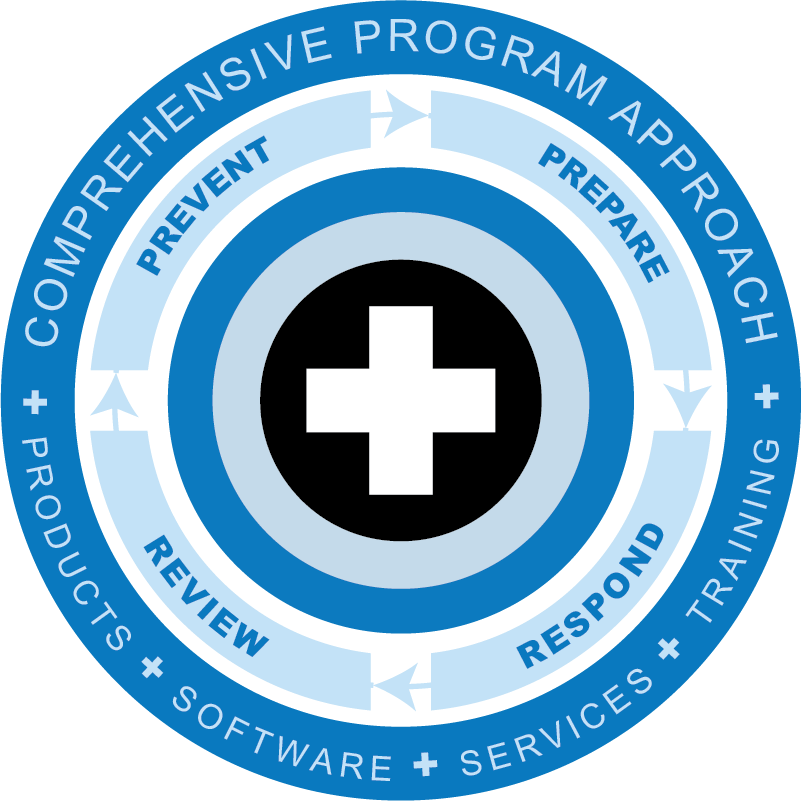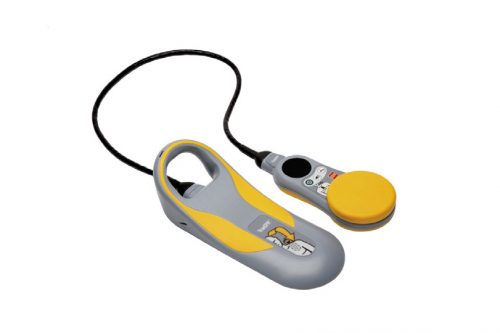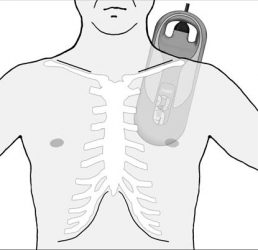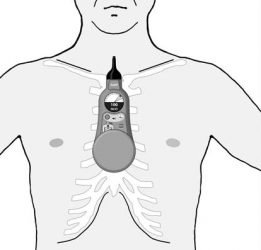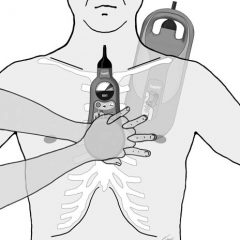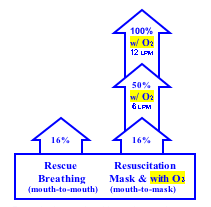Part 4: Basic Life Support (BLS) recognition of signs of sudden cardiac arrest (SCA), heart attack, stroke, and foreign-body airway obstruction (FBAO); cardiopulmonary resuscitation (CPR); and defibrillation with an automated external defibrillator (AED) for lay rescuers and healthcare providers.
During CPR the purpose of ventilation is to maintain adequate oxygenation …. therefore, both ventilations and compressions are important for victims of prolonged ventricular fibrillation SCA, when oxygen in the blood is utilized. Ventilations and compressions are also important for victims of asphyxial arrest, such as children and drowning victims who are hypoxemic at the time of cardiac arrest. Mouth-to-Mask Rescue Breathing and Bag-Mask Ventilation — Masks should include an oxygen inlet.
►… use supplemental oxygen at a flow rate of 10 to 12 LPM… to enable delivery of 100% oxygen (initially) (EDIT )…and the FDA regulation minimum capability of 6 LPM remains in effect. LIFE® 612™ models deliver both the FDA minimum of 6 LPM and the AHA recommended 100% inspired oxygen at 12 LPM, in just two simple settings which read “NORM” & “HIGH”. Only LIFE Corporation offers the 6 & 12 LPM (“NORM & HIGH”) simple 2 flow-rate choices.
Part 7.1: Adjuncts for Airway Control and Ventilation — recommendations for the support of ventilation and oxygenation during resuscitation and the periarrest period. The purpose of ventilation during CPR is to maintain adequate oxygenation and elimination of carbon dioxide. To improve sufficient oxygenation,
►… give 100% inspired oxygen during Basic Life Support (BLS)… and Advanced Cardiac Life Support (ACLS) … as soon as it becomes available. High inspired oxygen tension will tend to maximize arterial oxygen saturation and, in turn, arterial
oxygen content. This will help support oxygen delivery when cardiac output is limited.
●… short term oxygen therapy does not produce oxygen toxicity (… and should not be withheld for fear of suppressing respiration. — ref.2000AHA) Bag-Mask Ventilation requires adequate training and frequent practice, can produce gastric inflation with complications, including regurgitation, aspiration, pneumonia …and can decrease respiration. Advanced Airway endotracheal tube interventions are complicated, failure can occur …and there is no evidence that advanced airway measures improve survival rates in pre-hospital cardiac arrest.
Part 7.5: Post-Resuscitation Support — the provider should support adequate airway and breathing and… administer supplemental oxygen …
Part 9: Adult Stroke… several studies showing improved functional outcomes and survival in which higher supplementary oxygen concentrations were used… administer supplemental oxygen to hypoxemic stroke patients and those with unknown oxygen saturation.
Part 10.5: Near-Fatal Asthma — Primary Therapy – Oxygen… Provide oxygen to all patients with severe asthma, even those with normal oxygenation.
Part 10.6: Anaphylaxis – Intervention to Prevent Cardiopulmonary Arrest… administer oxygen at high flow rates.

GUIDELINES 2000 for Cardiopulmonary Resuscitation and Emergency Cardiovascular Care 2000 American Heart Association
Part 6: Advanced Cardiovascular Life Support
Section 3: Adjuncts for Oxygenation, Ventilation and Airway Control
(Edit Note: The © 2000 AHA Guidelines are Complimentary to the 1986 and 1992 AHA Guidelines on subject matters as excerpted below.)
Oxygenation Devices
- During cardiopulmonary emergencies use supplemental oxygen as soon as it is available. Rescue breathing (ventilation using exhaled air) will ONLY deliver approximately 16% to 17% inspired oxygen concentration to the patient.
- Tissue hypoxia leads to anaerobic metabolism and metabolic acidosis. Acid-base imbalance frequently blunts the effects of chemical and electrical therapy. For these reasons 100% inspired oxygen (FiO2 = 1.0) is recommended during BLS and ACLS when available.
- Short-term therapy with 100% oxygen is beneficial and not toxic.
Masks
- Masks should be fitted with an oxygen (insufflation) inlet.
- For mouth-to-mouth mask ventilation we recommend masks equipped with a 1-way valve that diverts the victim’s exhaled gas. Mouth-to mouth ventilation has been shown to be superior to that with bag-mask devices and delivering adequate tidal volumes on manikins.
- An adequate seal is best achieved with a mouth-to-mouth mask device when the rescuer is positioned at the top of the patient’s head. The rescuer ventilates the victim by sealing his or her lips around the coupling adapter of the mask. Use both hands to hold the mask securely in position and maintain airway patency with head tilt.

(EDIT) — We will continue to keep you advised as interpretations and the consensus develop. We are proud that our design evolutions over the past 20 years maintain our superiority in providing products that have met the AHA Guidelines of 1986, 1992, 2000, and 2005. LIFE Corporation

